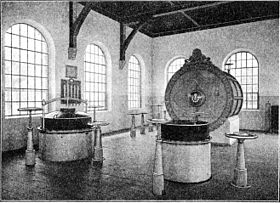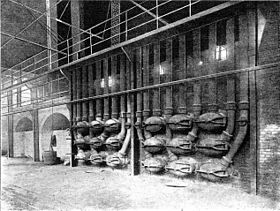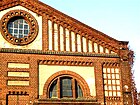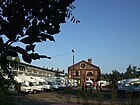Köpenicker Hof
The Köpenicker Hof is a cultural and tourism center on the listed site of the historic gas works in Berlin-Köpenick , which was built in 1889 as the first private gas plant in Berlin by the Budde & Goehde company .
location
The Köpenicker Hof is located on Stellingdamm, approx. 300 m from the Köpenick S-Bahn station , on the border with the historic Elsengrund Bauhaus settlement in the Treptow-Köpenick district. The historic buildings on the site were built for the 1st Köpenick gas works in 1889, among other things according to the plans of the city councilor Hugo Kinzer .
prehistory
The inventions and social changes that the industrial revolution brought with it had also reached Köpenick at the beginning of the 19th century . The old town of Köpenick was no longer sufficient for the growing population. The Kietzer Vorstadt (1873), the Köllnische Vorstadt (1874) and the Dammvorstadt (1883) were founded. In 1871 the population of Köpenick was 4,538, four years later there were already 7,113 inhabitants. The construction of new streets, squares, apartments and industrial plants as well as the conversion of street lighting from petroleum to gas increased the increasing demand for lighting gas. The British gas supply company Imperial-Continental-Gas-Association (ICGA), which operates across Europe, signed a contract with the Prussian government in 1925 for the gas supply to Berlin, which was valid for 21 years. From 1826 ICGA built the gas works on Friedrichshain's Spreeufer and supplied the street and squares in this area with luminous gas (1825 the gas works in Gitschiner Straße (Kreuzberg), 1836 the gas works in Holzmarktstraße, 1846 the Hellweg gas works in Kreuzberg). The steadily increasing demand for gas in Berlin led the Prussian authorities to consider taking the gas supply into their own hands. As a precaution, they bought land near the British company's gas works, which they used to build their own gas works after the expiry of some contracts with the English and thus the opening of the gas market in 1847.
The Köpenick city fathers granted the owners of the Budde & Goehde company an unlimited license to generate gas for the first private gas works in Köpenick. On November 1, 1889, the new gas station in Dahlwitzer Strasse (today Stellingdamm) was opened on a trial basis for gas lighting in today's old town and the Dammvorstadt.
history
The economic success of the gas works did not let the Köpenick city fathers rest and they began negotiations for the takeover by the city. Alexander Budde, now the sole owner, kept evasive, hired lawyers, but after two years of intense struggle he had to give up. With the agreement finally reached in October 1900, two fundamental questions were clarified at the same time:
- For the considerable price of 650,000 Reichsmarks, the city only acquired the gasworks and the 17.8 km of pipe network laid in Köpenick, all of the systems in Friedrichshagen's area remained with Budde.
- The supply of Adlershof had to be handed over to the English gas company IGGA, which had operated its own gas works in Oberschöneweide since 1899 and claimed the supply area for itself.
As early as 1901, the city authorities made fundamental decisions to completely rebuild the plant. First a container for 3,000 m³, which could be enlarged to 6,000 m³, was commissioned and in 1903 a new main pipe NW 400 mm was laid to the old town because the old one of NW 200 mm was no longer sufficient. The new building took place in 1904/05, and the property had to be enlarged to the north.
- Views of the Köpenick gas works after the renovation in 1905
Only the old furnace house (the western part of the first building), the 1,000 m³ gas tank, office / workshop and residential building remained. A new furnace house was built on the left behind the old one, on the right a cleaner house, a clock and regulator house, a boiler house, and on the left edge of the property a 63 m long coal shed and an administration building at the plant entrance.
The cost of the building without the internal machinery was for
| 1. the coal shed | 25,000.00 Mk |
| 2. the furnace house | 26,000.00 Mk |
| 3. the apparatus house with the collecting pits | 59,000.00 Mk |
| 4. the clock house | 10,000.00 Mk |
| 5. the boiler house with chimney | 6,000.00 Mk |
| 6. The abortion | 1,000.00 Mk |
| 7. the administration building | 20,000.00 Mk |
| 8. the terrain regulation, paving, sidewalks | 37,227.27 Mk |
| throughout | 184,227.72 Mk |
The designs for the buildings were drawn up in the city building department under the direction of the city master builder Hugo Kinzer ; the designs of the Pintsch company , Berlin, were used as the basis for the building to accommodate the mechanical systems . The construction management was in the hands of the municipal builder Hugo Kinzer and the site manager Arnold Zimmermann. The following were involved in the construction:
Earthwork and masonry work: Mr. architect and master mason Herm. Veal; Master mason Emil Wurl;
Carpentry: Mr. Carpenter Ms. Noack; Wagenknecht & Cunitz company;
Blacksmithing: the gas works;
Iron roof construction: Mr. Kaufmann Alb. Kienbaum;
Plumbing work: Master plumber Gustav Neumann; Mr. Plumber Hermann Beeck
Roofing work: Mr. Roofing Master Chr. Rabe
Delivery of the iron windows: Mr. Kaufmann Alb. Kienbaum;
Carpentry work: Mr. carpenter Israel; Wagenknecht & Cunitz company;
Locksmith work: Master locksmith Carl Mühlenberg;
Glazing work: Mr. Glazier Max Sieveit;
Painter, house painter and wallpapering work: Mr. painter Gebhardt;
Paving work: Mr. Engineer Ernst Selchow. Master stone setter Th. Hackradt.
With the opening of the new plants in October 1905, the plant capacity doubled to 10,000 m³ / day, the pipe network had grown to 31 km, 12,300 private flames and 420 street lamps were supplied, and the annual gas output had risen to over 1.5 million m³.
A further expansion was necessary as early as 1910–1915. First of all, the gas container was increased to 3,000 m³ by adding a telescope to 6,000 m³. In 1912 a new furnace house with 48 modern vertical retorts was built. For this, the office building had to be demolished. The first kiln house from 1889 was also no longer needed and demolished. In 1913 the apparatus house was enlarged and in 1915 the largest gas tank with 12,000 m³ was built and the first from 1889 (1,000 m³) was demolished.
- Interior views
With this stock, after the incorporation in 1920, the transition to the municipal gas works ( GASAG ) took place, which in 1925 took the plant out of operation in the course of rationalization. However, it was retained as the GASAG operating facility and the 12,000 m³ container was filled from the city network. Another long shed was built on the north-western border for the installation department and the large, massive coal sheds were rented out as garages for local buses. This situation did not change until the Second World War , when the gas container - like many others in Berlin - was severely damaged by bombs, which luckily did not hit the bull's eye. But it still took a good three years before it could be filled again after repairs at the end of 1948. After the commissioning of a new, large disc gas tank in Lichtenberg, it was then dispensable in 1965 and the entire area went to the municipal cleaning service ( BSR ) as a depot . This dismantled the upper parts of the container and used the so-called container basin in the 1980s to store aggressive de-icing agents for frozen roads. The final demolition of this lower section did not take place until 1994. From 1994 to 1998 the area served as a recycling yard.
Monument protection
- Industrial architecture of the Alte Köpenicker Gasanstalt
The buildings of the Köpenicker Hof and the former residential building of the Budde brothers on the adjacent property were added to the list of Berlin monuments:
09045792 Stellingdamm 15–15A, Städtisches Gaswerk Köpenick, 1899–1900, 1905 by Hugo Kinzer (architecture) and Julius Pintsch (technical design); Administration building, around 1910; Coal shed, 1905 (1928–29 converted into ABOAG garage); Office and administration building, 1905; New furnace house, 1905; Clock and regulator house, 1905 (1928–29 converted into a workshop building); Boiler house, 1905; Residential house, 1899; Camp, 1899
Todays use
The site has been used privately since 2006. Today KGT Köpenicker Tourismus GmbH operates a mobile home site, a guest house, a beer garden, restaurants, a cabaret and event rooms for celebrations.
literature
- The municipal gas works in Köpenick - origin and development up to 1906, published by the commission for the administration of the municipal gas works, 1906 Cöpenick, Heimatmuseum Köpenick.
- Hilmar Bärthel: The history of the gas supply in Berlin. A chronicle. Published by GASAG, Berliner Gaswerke, Aktiengesellschaft. Nicolai, Berlin 1997, ISBN 3-87584-630-3 .
Web links
Individual evidence
- ↑ Hilmar Bärthel: Köpenick events in the age of technology, Köpenick district office of Berlin - 1999, § 4.5 Gasworks Köpenick page 40/41
- ^ The municipal gas works in Köpenick - origin and development up to 1906, published by the commission for the administration of municipal gas works, 1906 Cöpenick, Heimatmuseum Köpenick.
Coordinates: 52 ° 27 '35 " N , 13 ° 35' 8.3" E














